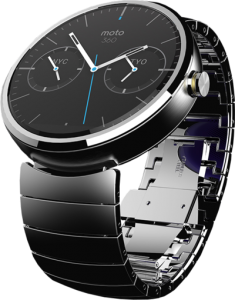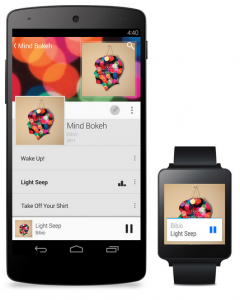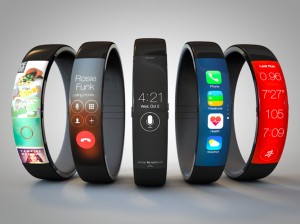It’s been about four years since Apple introduced a new device, aside from updates to current offerings, and the heat is on. In addition, rumors of a smartwatch developed by Apple have been floating around for a couple years now: a so-called Apple Watch. With the company set to unveil a new iPhone and possibly new devices this week, we may very well see the Apple Watch for the first time.
With all the recent unveilings of smartwatches – especially Android Wear devices like the Moto 360 – Apple is definitely going to have some stiff competition. It’s going to be interesting to see how they fare, but also what they come up with. What kind of vision does Apple have for the modern smartwatch?
Taking into account the current state of the market and what’s on offer, we’re going to explore some of the things Apple needs to offer for their upcoming Apple Watch in order to succeed. What are some features they definitely need to offer, and which ones can they improve upon?
What the Apple Watch Needs to Succeed
The smartwatch market is no longer barren, there are plenty of devices already available on the market with many more on the way. Furthermore, Google has improved the market by unveiling Android Wear – an operating system designed from the ground up for wearable devices. The best part about Android Wear is that it will be managed and maintained by Google and Google alone. That means no contending with forked versions of the software similar to what’s happened in the Android handset market.
Since Apple has always had a closed system going for it, with excellent software support and feature updates – the recent move by Google will change the end-game at least when it comes to smartwatches.
So, Apple is definitely going to need to buckle-down and offer an amazing device to beat the competition. In order to captivate buyers and ensure they choose the upcoming Apple Watch over the competition, they will need to offer some exclusive features and functionality. What are those exactly? Let’s take a closer look to find out.
Appearance is Most Important
Thanks to smartphones, people barely wear traditional watches now. There’s really no need because there are plenty of other ways to check the time. In specific situations a watch is useful – like when you’re diving underwater and keeping an eye on oxygen levels – but for the most part they are no longer necessary. This means that watches are worn as an accessory first and foremost. They are more akin to jewelry, than a modern gadget.
It is for that reason, appearance is everything when it comes to a smartwatch. Look at all the hype surrounding the Moto 360, and the one thing Motorola did with the device is offer a round watchface – unheard of until its unveiling. If Apple wants to beat out the competition with the Apple Watch then it needs to look sexy as hell. Not just that, it needs to look good on the wrist – or whereever people are wearing it.
If it looks too bulky, or dorky then no one is going to touch it. Obviously, we all want to see what Apple can come up with in terms of design, but let’s hope it’s unique and desirable.
Display Technology, Battery Life and General Size are Next
 There are three features which influence whether or not a new device sinks or swims in the current market: those include display tech, total battery life and the overall size of the device. So far, there isn’t a single smartwatch on the market that has managed to merge the best of all these features. The Moto 360 has a beautiful design and display, but it has shoddy battery life. The Pebble has excellent battery life in terms of whats on offer, but the original watch is bulky and somewhat unattractive.
There are three features which influence whether or not a new device sinks or swims in the current market: those include display tech, total battery life and the overall size of the device. So far, there isn’t a single smartwatch on the market that has managed to merge the best of all these features. The Moto 360 has a beautiful design and display, but it has shoddy battery life. The Pebble has excellent battery life in terms of whats on offer, but the original watch is bulky and somewhat unattractive.
Apple needs to create a device that uses a decent display – visible even in direct sunlight – with low power consumption ratings. In addition, the device needs to remain as thin as possible. I’ll venture to say it needs to be Skagen-thin. Wouldn’t that be something?
Even so, the Qualcomm Toq included a power-friendly display thanks to the company’s Mirasol technology and it offered damn good battery life for a smartwatch. Unfortunately, the colors of the display were not as vibrant or rich as high-quality LCD and OLED displays. Even worse, the entire device is thick as hell making you look like a serious dork while wearing one.
If Apple can overcome these three problems – which seem to run rampant in the current market – then they will have a winner on their hands.
The Apple Watch Needs to Be More Independent
Yes, it makes sense that a smartwatch can tether with a smartphone and pull information and content to the local device. That said, not everything a smartwatch does should be dictated by an active smartphone connection. A smartwatch should have some degree of independence, which strangely enough – we don’t see often in the smartwatch market. Of course, there are standalone devices such as the Samsung Gear S and the Neptune Pine but that’s not quite what we’re talking about.
For example, a smartwatch that cannot even display the time if disconnected from a smartphone is a huge problem. It is a watch, so it’s absolutely ridiculous if it cannot keep track of time independently.
In addition, this element can be expanded to include native app support, various internal functionality and more. It doesn’t really matter how Apple achieves it, nor what they offer on the grand scale – the Apple Watch needs to be more independent than current offerings. What the company is doing with their Continuity client is a fantastic example of independence.
The User Experience Matters
 Let’s face it, a lot of smartphones on the market really suck when it comes to usability. Android Wear is supposed to change that with voice controls – which work very well I might add – but that’s not the only answer to such a widespread problem.
Let’s face it, a lot of smartphones on the market really suck when it comes to usability. Android Wear is supposed to change that with voice controls – which work very well I might add – but that’s not the only answer to such a widespread problem.
Furthermore, it’s incredibly difficult to type on such a small display – at least one that would be equipped on a smartwatch. After all, that’s exactly why Android Wear devices are migrating towards voice controls.
The user experience matters bigtime when it comes to any device, and smartwatches are no different. However, it seems like a lot of manufacturers have forgotten such a core aspect of modern tech – let’s hope Apple doesn’t follow suit.
The Apple Watch needs to offer an exceptional user experience, and it needs to be better than the competition. Not only that, it needs to work well enough that people would even want to interact with their watch. This does seem like a silly and rather simple concept, but it’s a big one and it’s one that seems to be lacking from a lot of current devices.
The Apple Watch May Change the Game, or It May Not
The Apple Watch could be introduced to the market and ultimately make watches relevant again the world over. On the other hand, it could be unveiled and everyone could decide to avoid it like the plague. It’s all just speculation at this point and there’s no way to know what’s going to happen.
What is for certain though, is that Apple needs to improve greatly upon what the competition is currently doing. It doesn’t make sense to launch a device years behind the current state of the market. If Apple cannot compete with their rivals, or they launch a device that no one wants – then its back to the drawing board.
For a while, smartwatch enthusiasts almost needed Apple to change the game – the smartwatch market seemed to be in a slump. It looks like that has changed considerably over recent months, if only because innovation is already happening without them.
It’s time to see what Apple can do. It’s time to see what the Apple Watch will offer.


